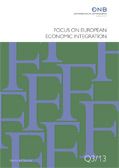Focus on European Economic Integration Q4/16
 OeNB
OeNB
- published:
- December 2016.
 OeNB
OeNB
Focus on European Economic Integration Q4/16 (PDF, 1.9 MB) December 2016.
Call for applications (PDF, 52 kB) Dec 19, 2016, 12:00:00 AM
Developments in selected CESEE countries: (PDF, 803 kB) Temporarily sluggish investment dampens CESEE growth whereas domestic demand continues to thrive Dec 19, 2016, 12:00:00 AM
Outlook for selected CESEE countries: (PDF, 228 kB) Steady growth in CESEE-6 after temporary dip in early 2016 – trough reached in Russia Dec 19, 2016, 12:00:00 AM
On the optimal number of indicators – nowcasting GDP growth in CESEE (PDF, 585 kB) Havrlant, Tóth, Wörz. We employ principal components and dynamic factor models for nowcasting GDP growth in selected Central, Eastern and Southeastern European (CESEE) economies. Our estimation sample extends from the first quarter of 2000 to the second quarter of 2008, our evaluation period from the third quarter of 2008 to the third quarter of 2014. For this period, we produce quasi out-of-sample forecasts of past-, current- and next-quarter GDP growth for seven CESEE economies. The models differ with respect to the estimation method, model specification, and the number of short-term indicators used. We find, first of all, a clear gain in predictive accuracy from using a nowcasting model with monthly indicators compared to the naïve benchmark. Furthermore, for our sample of small, open economies, we find that models using a smaller set of carefully selected indicators yield lower prediction errors on average than models based on larger information sets. Finally, we identify a clear gain in forecast performance from including foreign or euro area indicators. en nowcasting, dynamic factor models, principal components, Central, Eastern and Southeastern Europe C52, C53, E37 Dec 19, 2016, 12:00:00 AM
Currency substitution in CESEE: why do households prefer euro payments? (PDF, 586 kB) Scheiber, Stern. This paper uses microdata from 2014 to examine the determinants of currency substitution in Central, Eastern and Southeastern European (CESEE) countries. To analyze the hysteresis of euroization in these countries, we combine the standard search-theoretic model of money demand with recent findings on the preference of CESEE households for saving in cash as well as with aspects of economic geography. In Southeastern Europe, unlike in Central and Eastern Europe, network externalities and lower trust in the local currency than in the euro are still important factors. Expectations that the local currency will depreciate, income in euro and the expectation of an official adoption of the euro are important explanatory factors for all CESEE countries. Despite the heterogeneity across the region, our results suggest that institutions and policies that foster trust are key to promote de-euroization. euroization, currency substitution, hysteresis, microdata, CESEE E41, O16, D12, P34 Dec 19, 2016, 12:00:00 AM
CESEE-related abstracts from other OeNB publications (PDF, 86 kB) Dec 19, 2016, 12:00:00 AM
The OeNB’s 79th East Jour Fixe: Capital Flows to CESEE – Impact on Macro-Financial Stability and Policy Responses (PDF, 94 kB) Dec 19, 2016, 12:00:00 AM
Statistical annex (PDF, 125 kB) Dec 19, 2016, 12:00:00 AM